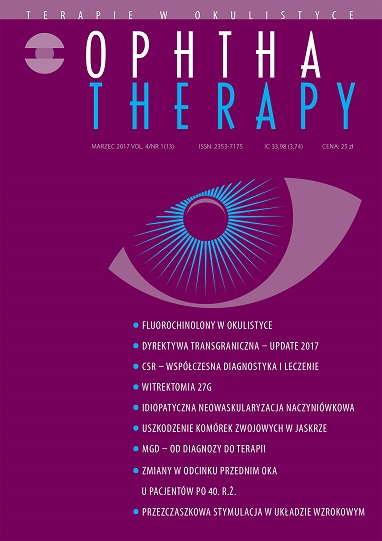Application of transcranial direct current stimulation in the visual system
Main Article Content
Abstract
The visual system may undergo both induced and spontaneous neuroplastic changes. Transcranial direct current stimulation is a method that allows direct modulation of the excitability of the cerebral cortex in humans and animals. Results from studies demonstrated beneficial effects of the method in the modulation of the excitability of occipital cortex of the brain. The use of transcranial stimulation enables improvement of visual functions, including enhanced quality of vision in amblyopia and stereoscopic vision. This article aims to characterize the method as adjunctive therapy, indicating its application in the treatment of the visual system.
Downloads
Article Details

This work is licensed under a Creative Commons Attribution-NonCommercial-NoDerivatives 4.0 International License.
Copyright: © Medical Education sp. z o.o. License allowing third parties to copy and redistribute the material in any medium or format and to remix, transform, and build upon the material, provided the original work is properly cited and states its license.
Address reprint requests to: Medical Education, Marcin Kuźma (marcin.kuzma@mededu.pl)
References
2. Stagg CJ, Nitsche MA. Physiological Basis of Transcranial Direct Current Stimulation. Neuroscientist. 2011; 17: 37-53.
3. Felleman DJ, Van Essen DC. Distributed hierarchical processing in the primate cerebral cortex. Cereb Cortex. 1991; 1: 1-47.
4. Tootell RB, Dale AM, Sereno MI et al. New images from human visual cortex. Trends Neurosci. 1996; 19: 481-9.
5. Foerster O. Beitrage zur Pathophysiologie der Sehbahn und der Sehsphare. J Psychol Neurol. 1929; 39: 435-63.
6. Penfield W, Boldrey E. Somatic motor and sensory representation in the cerebral cortex of man as studied by electrical stimulation. Brain. 1937; 60: 389-443.
7. Penfield W, Rasmussen T. The cerebral cortex of man. 4th ed. Macmillan, New York 1950.
8. Brindley GS, Lewin WS. The visual sensations produced by electrical stimulation of the medial occipital cortex. J Physiol. 1968; 194: 54-5P.
9. Merton PA, Morton HB. Stimulation of the cerebral cortex in the intact human subject. Nature. 1980; 285(5762): 227.
10. Cuypers K, Leenus DJF, van den Berg FE et al. Is Motor Learning Mediated by tDCS Intensity? PLoS One. 2013; 8(6): e67344.
11. Antal A, Nitsche M, Paulus W. External modulation of visual perception. Neuroreport. 2001; 12: 3553-5.
12. Antal A, Nitsche M, Kincses T et al. Facilitation of visuo-motor learning by transcranial direct current stimulation of the motor and extrastriate visual areas in humans. Eur J Neurosci. 2004; 19(10): 2888-92.
13. Antal A, Nitsche M, Kruse W et al. Direct current stimulation over V5 enhances visuomotor coordination by improving motion perception in humans. J Cogn Neurosci. 2004; 16: 521-7.
14. Kraft A, Roehmel J, Olma M et al. Transcranial direct current stimulation affects visual perception measured by threshold perimetry. Exp Brain Res. 2010; 207: 283-90.
15. Antal A, Kincses T, Nitsche M et al. Modulation of moving phosphene thresholds by transcranial direct current stimulation of V1 in human. Neuropsychologia. 2003; 41: 1802-7.
16. Antal A, Kincses Z, Nitsche M et al. Manipulation of phosphene thresholds by transcranial direct current stimulation in man. Exp Brain Res. 2003; 150: 375-8.
17. Sczesny-Kaiser M, Beckhaus K, Dinse HR et al. Repetitive Transcranial Direct Current Stimulation Induced Excitability Changes of Primary Visual Cortex and Visual Learning Effects – A Pilot Study. Front Behav Neurosci. 2016; 10: 116.
18. Holmes JM, Clarke MP. Amblyopia. Lancet. 2006; 367: 1343-51.
19. Sengpiel F, Jirmann KU, Vorobyov V et al. Strabismic suppression is mediated by inhibitory interactions in the primary visual cortex. Cereb Cortex. 2006; 16: 1750-8.
20. Hess RF, Mansouri B, Thompson B. Restoration of binocular vision of amblyopia. Strabismus. 2011; 19: 110-8.
21. Birch EE. Amblyopia and binocular vision. Prog Retin Eye Res. 2013; 33: 67-84.
22. Narasimhan S, Harrison E, Giaschi D. Quantitative measurement of interocular suppression in children with amblyopia. Vision Res. 2012; 66: 1-10.
23. Epelbaum M, Milleret C, Buisseret P et al. The sensitive period for strabismic amblyopia in humans. Ophthalmology. 1993; 100: 323-7.
24. Maya-Vetencourt JF, Baroncelli L, Viegi A et al. IGF-1 restores visual cortex plasticity in adult life by reducing local GABA levels. Neural Plas. 2012; 2012: 250421.
25. He HY, Hodos W, Quinlan EM. Visual deprivation reactivates rapid ocular dominance plasticity in adult visual cortex. J Neurosci. 2006; 26: 2951-5.
26. Harauzov A, Spolidoro M, Dicristo G et al. Reducing intracortical inhibition in the adult visual cortex promotes ocular dominance plasticity. J Neurosci. 2010; 30: 361-71.
27. Sale A, Maya-Vetencourt JF, Medini P. Environmental enrichment in adulthood promotes amblyopia recovery through a reduction of intracortical inhibition. Nat Neurosci. 2007; 10: 679-81.
28. Sale A, Berardi N, Spolidoro M et al. GABAergic inhibition in visual cortical plasticity. FrontCell Neurosci. 2010; 4: 10.
29. Knox P, Simmers A, Gray L et al. An exploratory study: prolonged periods of binocular stimulation can provide an effective treatment for childhood amblyopia. Invest Ophthalmol Vis Sci. 2012; 53: 817-24.
30. To L, Thompson B, Blum J et al. A game platform for treatment of amblyopia. IEEE Trans Neural Syst Rehabil Eng. 2011; 19(3): 280-9.
31. Spiegel DP, Li J, Hess RF et al. Transcranial Direct Current Stimulation Enhances Recovery of Stereopsis in Adults With Amblyopia. Neurotherapeutics. 2013; 10: 831-9.
32. Ding Z, Li J, Spiegel DP et al. The effect of transcranial direct current stimulation on contrast sensitivity and visual evoked potential amplitude in adults with amblyopia. Sci Rep. 2016; 6: 19280.
33. Plow E, Obretenova S, Halko M et al. Combining visual rehabilitative training and noninvasive brain stimulation to enhance visual function in patients with hemianopia: a comparative case study. PM R. 2011; 3(9): 825-35.

